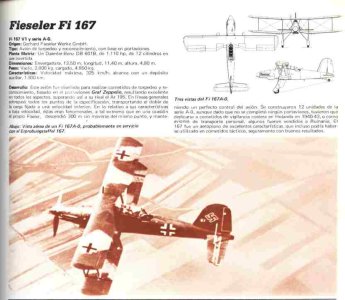To meet a requirement for a ship-based two-seat torpedo bomber/reconnaissance aircraft, both Arado and Fieseler submited proposals to the RLM. Prototypes of both aircraft were built, but testing in late 1938 soon showed that Arado's AR 195 could not meet the requirements, whereas the Fieseler Fi 167 could not only meet but considerably exceed the specification. In configuration the Fieseler design was a two-bay foldable wing biplane, primarily of metal construction but with some fabric covering, fixed tailwheel landing gear with tall jettisonable main units, a conventional braced tail unit and a Daimler Benz DB 601 engine. The two-man crew was accommodated in tandem, beneath a long canopy that was designed to allow for operation at the rear of a machine-gun on a pivoted mount.
As with the Fi 156 Storch, Fieseler's new aircraft had exceptional low-speed characteristics, achieved in this case by both wings incorporating ailerons and full-span automatic leading edge slats, and the lower wing having large area trailing-edge flaps. Their effect, allied with the lift of the biplane wings, made it possible for the aircraft to sink slowly and almost vertically under complete control.
The Fi 167 was intended for service aboard the German aircraft carrier Graf Zeppelin, launched on 8 December 1938, and following the completion of a second prototype a pre-production batch of 12 Fi-167 aircraft was built. These differed little from the prototypes, but incorporated some refinements considered desireable after service testing, including the addition of a two-man dinghy. When construction of the Graf Zeppelin was stopped, in 1940, the role for which the Fi 167 had been designed no longer existed. However, it was expected that when construction resumed, manufacture of the Fi 167 would also go ahead; this was not to be the case for when, in 1942, orders were given for construction of the aircraft-carrier to be resumed, it was decided that the Ju87C would amply meet requirements, and no further examples of the Fi 167 were built. Erprobungsstaffel 167 was established in the summer of 1940 for a series of evaluations, based in Holland. A number of tests were undertaken, including those of various overwater camouflage schemes. The unit remained there until early 1943, when the Fi 167s were dispersed: three to an undercarriage testing unit and the rest to Romania.
Engine:
Model: Daimler-Benz DB601B
Type: 12-Cylinder liquid cooled inverted vee
Number: One Horsepower: 1,100 hp
Performance:
Maximum Speed (Recon): 202 mph (325 kph)
Maximum Speed (Bomber): 199 mph
Normal Cruise: 155 mph
Range (Recon w. drop tanks): 932 miles
Range (Max. Payload): 808 miles (1300 km)
Initial Climb: N/A
Service Ceiling: 24,600-26900 ft.
Armament:
One 7.9mm MG 17 machine gun, forward firing, fixed in starboard forward fuselage with 500 rounds.
One 7.9mm MG 15 machine gun on flexible mount in observer's cockpit, 600 rounds carried.
Bombload:
Normal Load:
Four 110 lb. SC 50 bombs & One 551 lb. SC 250 or 1,102 lb. SC 500 bomb.
Maximum Load:
One 2,205 lb. SD 1000 bomb or one 1,685.5 lb. LT F5b torpedo.
 . tell me your opinion, please
. tell me your opinion, please . tell me your opinion, please
. tell me your opinion, please
 for me
for me .
.
 .
. ), buddy!!!
), buddy!!!
 sooo basically the built of British and German ships was diametrically opposed, as far as the armouring is concerned, since the British designs from the last war were still floating around
sooo basically the built of British and German ships was diametrically opposed, as far as the armouring is concerned, since the British designs from the last war were still floating around 

